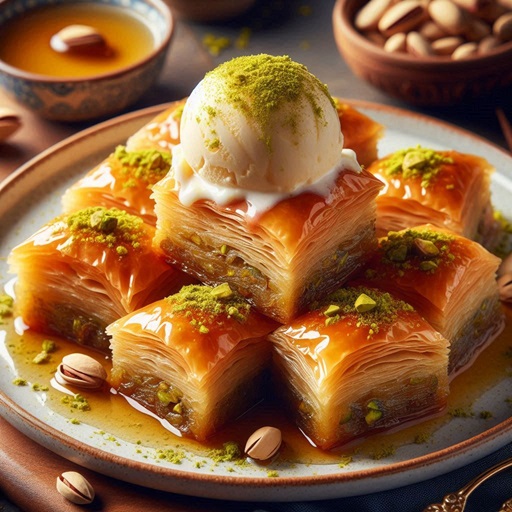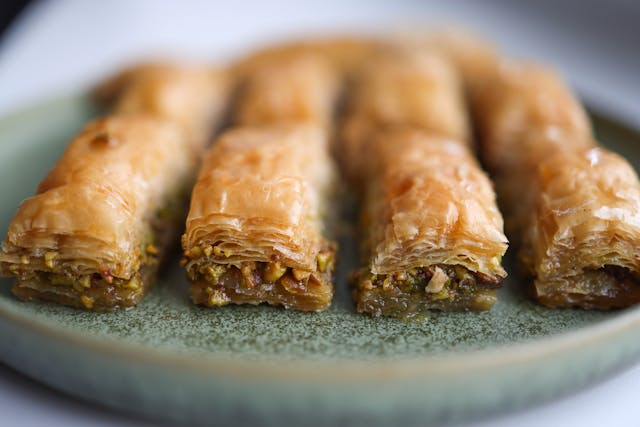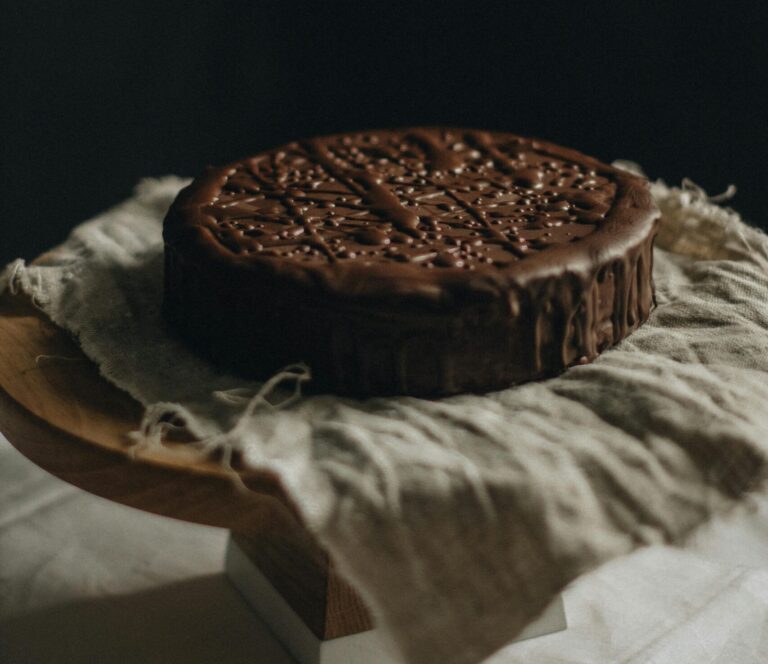“Baklava Recipe: Golden Layers of Flavor and Tradition”
Baklava (recipe), a dessert that evokes the richness and cultural diversity of the Middle East, has an origin as fascinating as its flavor. Although its creation is claimed by several cultures, it is believed that its roots date back to ancient Mesopotamia, where similar preparations were made. However, baklava as we know it today has been shaped by Turkish, Greek and Arabic influences over the centuries.
The Turkish version of baklava is perhaps the best known. The Ottomans perfected the recipe during their empire, and it is said that the sultan used to offer baklava to his janissaries in an annual ceremony. In Greece, baklava is characterized by the use of honey and nuts, ingredients that provide a unique flavor and texture. In the Arab world, a combination of dried fruits such as pistachios and almonds is used, as well as a touch of rose or orange blossom water, which adds a delicate fragrance to the dessert.
Regional differences in the preparation of baklava not only enrich its flavor, but also reflect the cultural diversity of those who prepare it. In Turkey, for example, baklava is usually prepared with very thin layers of filo dough, while in other regions, the layers may be thicker and fewer in number. Likewise, the choice of nuts and sweeteners varies considerably, resulting in a wide range of versions of this delicious dessert.
Baklava is not only a delight for the palate, but also a symbol of celebration. In many cultures, it is consumed during holidays and special events. In Turkey, it is common to enjoy baklava during Eid al-Fitr celebrations, which marks the end of Ramadan. In Greece, it is a typical dessert for Christmas festivities and Orthodox Easter.
Thus, baklava is not just a dessert; It is a historical and emotional bond that unites diverse cultures through its irresistible flavor and rich history. By exploring its origins and curiosities, we can further appreciate the depth and cultural legacy that each bite of baklava brings with it.

Receta Paso a Paso para Preparar Baklava en Casa
Baklava is an exquisite dessert originating from the Middle East, known for its sweet flavor and crunchy texture. Making it at home may seem intimidating, but with this step-by-step recipe, even cooking beginners will be able to achieve delicious, authentic baklava. The necessary ingredients and preparation instructions are listed below.
We Need
500 g filo dough sheets
300 g of nuts (can be almonds, pistachios or a mix)
300 g of nuts (can be almonds, pistachios or a mix)
250 ml of honey
1 teaspoon ground cinnamon
1/2 teaspoon ground cloves
1/4 teaspoon salt
Lemon zest
and a lot of love,essential to obtain the richest desserts
DIRECTIONS
ONE Filling Preparation:To start, grind the walnuts in a food processor until you have small, but not too fine, pieces. Mix the crushed walnuts with the cinnamon, cloves and salt. This combination of spices will add a deep and aromatic flavor to the baklava.
TWO Preparation of the Dough: Unroll the sheets of phyllo dough and cover them with a damp cloth to prevent them from drying out. Melt the butter and keep it on hand, as you will need it to spread each layer of dough. Preheat the oven to 175°C (350°F).
THREE Assembling the Baklava: Grease a rectangular tray with butter. Place a sheet of filo dough on the bottom of the tray and spread it with melted butter. Repeat this process with approximately 8-10 sheets. Then, spread a layer of the nut filling. Continue alternating layers of phyllo dough and nut filling until you are done with all the ingredients, making sure to end with a layer of phyllo dough.
FOUR Cutting the Baklava: Use a sharp knife to cut the baklava into portions before baking. You can cut into squares, triangles or diamonds, depending on your preference.
FIVE Baking: Bake the baklava in the preheated oven for 45-50 minutes, or until golden and crispy. While it bakes, make the honey syrup by heating the honey, sugar and lemon zest in a saucepan over medium heat until the sugar is completely dissolved.
SIX Completion: Once the baklava is baked, immediately pour the hot syrup over the cut portions. This will allow the baklava to absorb the syrup and acquire its characteristic sweet flavor and juicy texture.
Helpful tips
To avoid common mistakes, make sure the filo dough sheets are always covered with the damp cloth and do not skip any layer of butter, as this ensures crispy baklava. Also, when pouring the hot syrup over the freshly baked baklava, make sure to do it evenly so that all the layers absorb the liquid properly.
By following these steps and tips, you’ll be well on your way to enjoying delicious homemade baklava.
Varieties and Tips to Personalize your Baklava
Baklava is a versatile dessert that allows for countless variations, allowing each cook to give it a personal touch. Walnuts play a crucial role in creating unique baklava. Traditionally, pistachios, almonds and walnuts are used. However, there are no hard and fast rules: you can experiment with hazelnuts, macadamia nuts, or even a mix of several nuts. Each type of nut provides a distinctive flavor and texture; For example, pistachios add a pop of vibrant green color and a slightly sweet flavor, while almonds offer a softer crunch and more neutral flavor.
Another way to customize your baklava is by choosing the syrup. Although sugar and honey syrup is the most common, you can infuse it with different flavors for a special touch. Rose water and orange blossom water are popular additions that provide a floral aroma and exotic flavor. For those looking for something more traditional, adding a little cinnamon or cloves to the syrup can provide additional warmth that perfectly complements the layers of filo dough and nuts.
In addition to customizing the ingredients, it is essential to know some tips to ensure that your baklava is consumed in its best state. Baklava should be stored at room temperature in an airtight container to maintain its freshness and prevent it from becoming soggy. If you prefer to keep it longer, you can refrigerate it, but be sure to leave it at room temperature before serving so that it regains its crunchy texture.
Finally, presentation can make a big difference when serving baklava to your guests. Cut the baklava into small geometric pieces, such as triangles or diamonds, for a more sophisticated look. You can add a finishing touch by sprinkling a little chopped walnuts or citrus zest on top. The key is to experiment and have fun with the process, creating a version of baklava that is unique and delicious.





